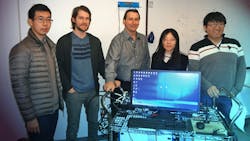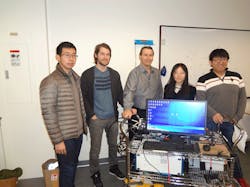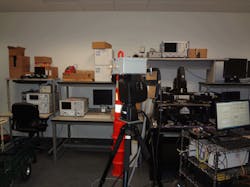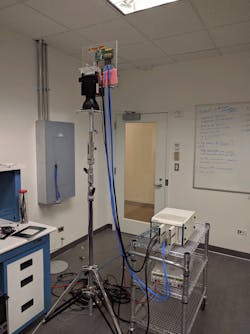Recently, I had the opportunity to visit NYU Wireless and talk to Founding Director Theodore Rappaport. Rappaport took myself and Chris DeMartino (technology editor for Electronic Design’s sister brand, Microwaves & RF) for a tour around the labs to see the various projects underway, as well as to meet the team of researchers working under his supervision. Before the tour, I spoke to him about the advances that are underway regarding wireless communications, and what the future holds for this area.
Rappaport foresees mobile communication systems operating in frequencies higher than 100 GHz. He also envisions smartphones having a large amount of sensors and antennas while consuming very small amounts of power. He mentioned that smartphones might be controlled by hand gestures with common features, such as 3D navigation and control, 3D videos, holograms, virtual reality, augmented reality, and sensing imaging.
At NYU Wireless, researchers are focusing on such diverse areas as prototyping and simulation software, millimeter-wave (mm-wave) channel modeling, and medical. By thinking ahead—even beyond 5G—they are creating the technology that we will probably be using in 10 years’ time.
The first stop of the tour was the channel sounding lab, which focuses on channel characteristics and radio propagation. There, I met some of the researchers (Fig. 1) whose work has demonstrated that a Line of Sight (LOS) is not necessary for millimeter-wave systems using their rotational mechanical systems (Fig.2). The team of researchers created a physical model based on sampling different urban environments and scenarios—specifically, in Manhattan and Brooklyn—to create an overall physical model that people can use, rather than having to go into the field and conduct their own measurements.
“We rotate the antennas along the azimuth and elevation planes at many different angles in order to gain an omnidirectional sense of the environment,” said George MacCartney, a Ph.D. student. “A study can take anywhere from a few days to many months, actually depending of the type of analysis and observations.
“A small-scale study, for example, is to study the effect of a human body walking through a point-to-point link, and also taking diffraction measurements to see how the waves might bend around the material or a corner of structure in both indoor and outdoor environments,” MacCartney added. “In the future, measurements will be more advanced—using phased arrays to do very fast measurements—where the beams will be steered electronically and not mechanically.”
“We take the knowledge of the radio channel and put it into software,” Rappaport added. “We have over 5,000 people in engineering companies around the world that are using NYUSIM channel simulator, which is freely downloadable.”
The next and last stop on the tour was the phased array lab, where we met Ph.D. candidate Chris Slezak and postdoctoral research fellow Aditya Dhananjay (who is also the co-founder and president of MilliLabs). They are in charge of the research that focuses purely on millimeter-wave communications. More specifically, they concentrate on what happens once you get the signal from a transmitter to a receiver—i.e., exactly how to process the signal to get the information.
Dhananjay described to us the function and importance of phased-array system (Fig. 3):“In the lab, we can turn the antennas around without a problem. But in reality, that is not how you steer beams because you want to steer beams in the order of microseconds. To do that, you need a phased-array system.
“A phased-array system controls the signals that come out of the antennas and changes the timing of phase between them,” he continued. “You can control which direction the waves propagate in and on which other directions the waves cancel out.”
Right now, the lab is concentrating on how the phased-array devices behave by working with equipment from National Instruments and Keysight Technologies. The idea of having beams moving in microseconds allows for a continuous link between a transmitter and a receiver. “In the future,” Dhananjay concluded, “the idea is to have phased-array antennas in mobile devices and base stations, because they will help to point toward any reflector and have a link between a transmitter and a receiver, even though there is no direct LOS.”
As I saw and learned during my visit to NYU Wireless, millimeter-wave systems offer great potential and benefits to the next generation of wireless technology. Clearly, there is more to come in mm-wave studies for cellular networks in cities and rural regions. As researchers at NYU Wireless and other institutions and companies keep breaking ground, I will follow their progress and keep you updated.
About the Author
Maria Guerra Blog
Power/Analog Editor
Maria Guerra is the Power/Analog Editor for Electronic Design. She is an Electrical Engineer with an MSEE from NYU Tandon School of Engineering. She has a very solid engineering background and extensive experience with technical documentation and writing. Before joining Electronic Design, she was an Electrical Engineer for Kellogg, Brown & Root Ltd (London. U.K.). During her years in the Oil and Gas Industry she was involved in a range of projects for both offshore and onshore designs. Her technical and soft skills bring a practical, hands-on approach to the Electronic Design team.




